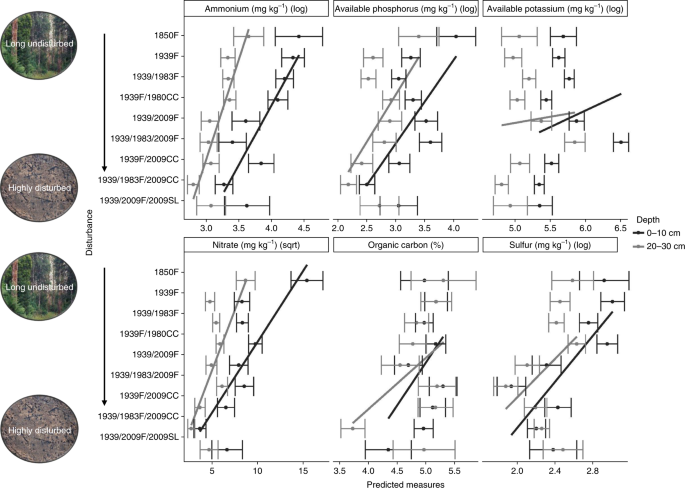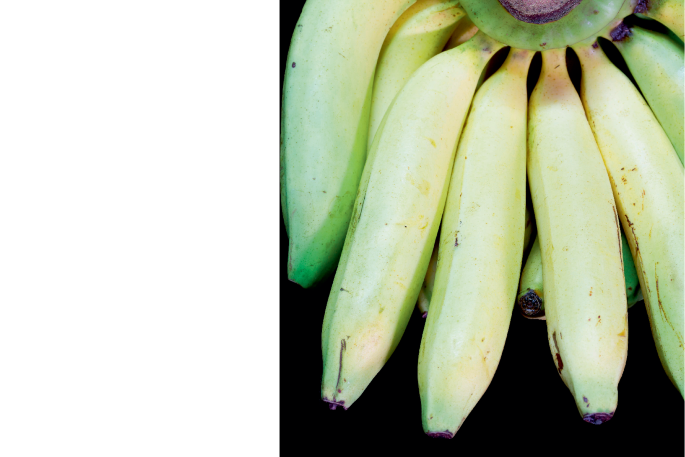
- Select a language for the TTS:
- UK English Female
- UK English Male
- US English Female
- US English Male
- Australian Female
- Australian Male
- Language selected: (auto detect) - EN
Play all audios:
ABSTRACT Soils are a fundamental component of terrestrial ecosystems, and play key roles in biogeochemical cycles and the ecology of microbial, plant and animal communities. Global increases
in the intensity and frequency of ecological disturbances are driving major changes in the structure and function of forest ecosystems, yet little is known about the long-term impacts of
disturbance on soils. Here we show that natural disturbance (fire) and human disturbances (clearcut logging and post-fire salvage logging) can significantly alter the composition of forest
soils for far longer than previously recognized. Using extensive sampling across a multi-century chronosequence in some of the tallest and most carbon-dense forests worldwide (southern
Australian, mountain ash (_Eucalyptus regnans_) forests), we provide compelling evidence that disturbance impacts on soils are evident up to least eight decades after disturbance, and
potentially much longer. Relative to long-undisturbed forest (167 years old), sites subject to multiple fires, clearcut logging or salvage logging were characterized by soils with
significantly lower values of a range of ecologically important measures at multiple depths, including available phosphorus and nitrate. Disturbance impacts on soils were most pronounced on
sites subject to compounding perturbations, such as multiple fires and clearcut logging. Long-lasting impacts of disturbance on soil can have major ecological and functional implications.
Access through your institution Buy or subscribe This is a preview of subscription content, access via your institution ACCESS OPTIONS Access through your institution Access Nature and 54
other Nature Portfolio journals Get Nature+, our best-value online-access subscription $29.99 / 30 days cancel any time Learn more Subscribe to this journal Receive 12 print issues and
online access $259.00 per year only $21.58 per issue Learn more Buy this article * Purchase on SpringerLink * Instant access to full article PDF Buy now Prices may be subject to local taxes
which are calculated during checkout ADDITIONAL ACCESS OPTIONS: * Log in * Learn about institutional subscriptions * Read our FAQs * Contact customer support SIMILAR CONTENT BEING VIEWED BY
OTHERS MULTISCALE RESPONSES AND RECOVERY OF SOILS TO WILDFIRE IN A SAGEBRUSH STEPPE ECOSYSTEM Article Open access 23 December 2022 FIRE-DRIVEN DISRUPTIONS OF GLOBAL SOIL BIOCHEMICAL
RELATIONSHIPS Article Open access 30 January 2025 ANNUAL GRASS INVASIONS AND WILDFIRE DEPLETE ECOSYSTEM CARBON STORAGE BY >50% TO RESISTANT BASE LEVELS Article Open access 11 November
2024 DATA AVAILABILITY The data that support the findings of this study are available in the Supplementary Information and from the corresponding author upon request. REFERENCES * Bowman, D.
M. et al. Fire in the Earth system. _Science_ 324, 481–484 (2009). Article Google Scholar * Fraver, S. et al. Forest structure following tornado damage and salvage logging in northern
Maine, USA. _Can. J. For. Res._ 47, 560–564 (2017). Article Google Scholar * Seidl, R., Schelhaas, M. J., Rammer, W. & Verkerk, P. J. Increasing forest disturbances in Europe and their
impact on carbon storage. _Nat. Clim. Change_ 4, 806–610 (2014). Article Google Scholar * Bond, W. J. J., Woodward, F. I. I. & Midgley, G. F. F. The global distribution of ecosystems
in a world without fire. _New Phytol._ 165, 525–537 (2005). Article Google Scholar * Giglio, L., Randerson, J. T. & van der Werf, G. R. Analysis of daily, monthly, and annual burned
area using the fourth-generation global fire emissions database (GFED4). _J. Geophys. Res. Biogeosci._ 118, 317–328 (2013). Article Google Scholar * Van Der Werf, G. R. et al. Global fire
emissions estimates during 1997–2016. _Earth Syst. Sci. Data_ 9, 697–720 (2017). Article Google Scholar * Cochrane, M. A. & Laurance, W. F. Synergisms among fire, land use, and climate
change in the Amazon. _Fire Ecol. Manag._ 37, 522–527 (2008). Google Scholar * Lindenmayer, D. B., Hobbs, R. J., Likens, G. E., Krebs, C. J. & Banks, S. C. Newly discovered landscape
traps produce regime shifts in wet forests. _Proc. Natl Acad. Sci. USA_ 108, 15887–15891 (2011). Article Google Scholar * Diochon, A., Kellman, L. & Beltrami, H. Looking deeper: an
investigation of soil carbon losses following harvesting from a managed northeastern red spruce (_Picea rubens_ Sarg.) forest chronosequence. _For. Ecol. Manage._ 257, 413–420 (2009).
Article Google Scholar * Pellegrini, A. F. A. et al. Fire frequency drives decadal changes in soil carbon and nitrogen and ecosystem productivity. _Nature_ 553, 194–198 (2018). Article
Google Scholar * Watson, J. E. M. et al. The exceptional value of intact forest ecosystems. _Nat. Ecol. Evol._ 2, 599–610 (2018). Article Google Scholar * De Deyn, G. B., Raaijmakers, C.
E. & Van Der Putten, W. H. Plant community development is affected by nutrients and soil biota. _J. Ecol._ 92, 824–834 (2004). Article Google Scholar * Mckenzie, N., Jacquier, D.,
Isbell, R. & Brown, K. _Australian Soils and Landscapes: An Illustrated Compendium_ (CSIRO Publishing, Collingwood, 2004). * Blum, W. E. H. Functions of soil for society and the
environment. _Rev. Environ. Sci. Bio/Technol._ 4, 75–79 (2005). Article Google Scholar * Tedersoo, L. et al. Global diversity and geography of soil fungi. _Science_ 346, 1052–1053 (2014).
Article Google Scholar * Paustian, K. et al. Climate-smart soils. _Nature_ 532, 49–57 (2016). Article Google Scholar * van der Putten, W. H. et al. Plant-soil feedbacks: the past, the
present and future challenges. _J. Ecol._ 101, 265–276 (2013). Article Google Scholar * Hume, A. M., Han Chen, Y. H., Taylor, A. R. & Han, C. Intensive forest harvesting increases
susceptibility of northern forest soils to carbon, nitrogen and phosphorus loss. _J. Appl. Ecol._ 55, 246–255 (2018). Article Google Scholar * Prest, D., Kellman, L. & Lavigne, M. B.
Mineral soil carbon and nitrogen still low three decades following clearcut harvesting in a typical acadian forest stand. _Geoderma_ 214-215, 62–69 (2014). Article Google Scholar * Bowman,
D. M. J. S., Murphy, B. P., Neyland, D. L. J., Williamson, G. J. & Prior, L. D. Abrupt fire regime change may cause landscape-wide loss of mature obligate seeder forests. _Glob. Change
Biol._ 20, 1008–1015 (2014). Article Google Scholar * Clarke, H. G., Smith, P. L. & Pitman, A. J. Regional signatures of future fire weather over eastern Australia from global climate
models. _Int. J. Wildl. Fire_ 20, 550–562 (2011). Article Google Scholar * McCarthy, M. A., Malcolm Gill, A. & Lindenmayer, D. B. Fire regimes in mountain ash forest: evidence from
forest age structure, extinction models and wildlife habitat. _For. Ecol. Manage._ 124, 193–203 (1999). Article Google Scholar * Burns, E. L. et al. Ecosystem assessment of mountain ash
forest in the Central Highlands of Victoria, south-eastern Australia. _Austral. Ecol._ 40, 386–399 (2015). Article Google Scholar * Florence, R. _Ecology and Silviculture of Eucalypt
Forests_ (CSIRO Publishing, Collingwood, 1996). * Commonwealth Scientific and Industrial Research Organisation (CSIRO) _Climate Variability and Change in South-eastern Australia: A Synthesis
of Findings from Phase 1 of the South Eastern Australian Climate Initiative_ _(SEACI)_ (CSIRO Publishing, 2010). * Taylor, C., Mccarthy, M. A. & Lindenmayer, D. B. Nonlinear effects of
stand age on fire severity. _Conserv. Lett._ 7, 355–370 (2014). Article Google Scholar * Bissett, A. et al. Introducing BASE: the Biomes of Australian Soil Environments soil microbial
diversity database. _Gigascience_ 5, 21 (2016). Article Google Scholar * Certini, G. Effects of fire on properties of forest soils: a review. _Oecologia_ 143, 1–10 (2005). Article Google
Scholar * Malvar, M. C. et al. Short-term effects of post-fire salvage logging on runoff and soil erosion. _For. Ecol. Manage._ 400, 555–567 (2017). Article Google Scholar * Wilson, C. J.
Effects of logging and fire on runoff and erosion on highly erodible granitic soils in Tasmania. _Water Resour. Res._ 35, 3531–3546 (1999). Article Google Scholar * Bowd, E. J.,
Lindenmayer, D. B., Banks, S. C. & Blair, D. P. Logging and fire regimes alter plant communities. _Ecol. Appl._ 28, 826–841 (2018). Article Google Scholar * Rab, M. A. Recovery of soil
physical properties from compaction and soil profile disturbance caused by logging of native forest in Victorian Central Highlands, Australia. _For. Ecol. Manage._ 191, 329–340 (2004).
Article Google Scholar * Zummo, L. M. & Friedland, A. J. Soil carbon release along a gradient of physical disturbance in a harvested northern hardwood forest. _For. Ecol. Manage._ 261,
1016–1026 (2011). Article Google Scholar * Simard, D. G., Fyles, J. W., Paré, D., Nguyen, T. & Nguyen, D. Impacts of clearcut harvesting and wildfire on soil nutrient status in the
Quebec boreal forest. _Can. J. Soil Sci._ 81, 229–237 (2001). Article Google Scholar * Menge, D. N. L., Pacala, S. W. & Hedin, L. O. Emergence and maintenance of nutrient limitation
over multiple timescales in terrestrial emergence and maintenance of nutrient limitation over multiple timescales in terrestrial ecosystems. _Source Am. Nat._ 173, 164–175 (2009). Article
Google Scholar * Ashton, D. H. in _Fire and the_ _Australian Biota_ (eds Gill, A. M., Groves, R. H. & Noble, I. R.) 339–366 (Australian Academy of Science, Canberra, 1981). * Bélanger,
N., Côté, B., Fyles, J. W., Courchesne, F. & Hendershot, W. L. H. Forest regrowth as the controlling factor of soil nutrient availability 75 years after fire in a deciduous forest of
Southern Quebec. _Plant Soil_ 262, 363–372 (2004). Article Google Scholar * Chambers, A. B. & Attiwill, P. The ash-bed effect in Eucalyptus regnans forest: chemical, physical and
microbiological changes in soil after heating or partial sterilisation. _Austral. J. Bot._ 42, 739–749 (1994). Article Google Scholar * Polglase, P. J. & Attiwill, P. M. Nitrogen and
phosphorus cycling in relation to stand age of _Eucalyptus regnans_ F. Muell. I. Return from plant to soil in litterfall. _Plant Soil_ 142, 157–166 (1992). Article Google Scholar *
Dijkstra, F. A. et al. Enhanced decomposition and nitrogen mineralization sustain rapid growth of _Eucalyptus regnans_ after wildfire. _J. Ecol._ 105, 229–236 (2017). Article Google Scholar
* May, B. M. M. & Attiwill, P. M. M. Nitrogen-fixation by _Acacia dealbata_ and changes in soil properties 5 years after mechanical disturbance or slash-burning following timber
harvest. _For. Ecol. Manage._ 181, 339–355 (2003). Article Google Scholar * Russell, A. E. & Raich, J. W. Rapidly growing tropical trees mobilize remarkable amounts of nitrogen, in
ways that differ surprisingly among species. _Proc. Natl Acad. Sci. USA_ 109, 10398–10402 (2012). Article Google Scholar * Moritz, M. A. et al. Climate Change and disruptions to global
fire activity. _Ecosphere_ 3, 49 (2012). Article Google Scholar * Bowman, D. M. J. S. et al. The human dimension of fire regimes on Earth. _J. Biogeogr._ 38, 2223–2236 (2011). Article
Google Scholar * Kishchuk, B. E. et al. Decadal soil and stand response to fire, harvest, and salvage-logging disturbances in the western boreal mixedwood forest of Alberta, Canada. _Can.
J. For. Res._ 45, 141–152 (2015). Article Google Scholar * Turner, B. L., Brenes-Arguedas, T. & Condit, R. Pervasive phosphorus limitation of tree species but not communities in
tropical forests. _Nature_ 555, 367–370 (2018). Article Google Scholar * Alvarez-Clare, S., Mack, M. C. & Brooks, M. A direct test of nitrogen and phosphorus limitation to net primary
productivity in a lowland tropical wet forest. _Ecology_ 94, 1540–1551 (2013). Article Google Scholar * Lindenmayer, D. B. & Laurance, W. F. The ecology, distribution, conservation and
management of large old trees. _Biol. Rev._ 92, 1434–1458 (2017). Article Google Scholar * Blair, D. P., McBurney, L. M., Blanchard, W., Banks, S. C. & Lindenmayer, D. B. Disturbance
gradient shows logging affects plant functional groups more than fire. _Ecol. Appl._ 26, 2280–2301 (2016). Article Google Scholar * Keenan, R. J. & Nitschke, C. Forest management
options for adaptation to climate change: a case study of tall, wet eucalypt forests in Victoria’s Central Highlands region. _Aust. For._ 79, 96–107 (2016). Article Google Scholar *
Mackey, B., Lindenmayer, D., Gill, M., McCarthy, M. & Lindesay, J. _Wildlife, Fire and Future Climate: A Forest Ecosystem Analysis_ (CSIRO Publishing, Collingwood, 2002). * Ough, K.
& Murphy, A. Decline in tree-fern abundance after clearfell harvesting. _For. Ecol. Manage._ 199, 153–163 (2004). Article Google Scholar * Lindenmayer, D. B. & Franklin, J. F.
Managing stand structure as part of ecologically sustainable forest management in Australian mountain ash forests. _Conserv. Biol._ 11, 1053–1068 (1997). Article Google Scholar *
Lindenmayer, D. B. & Ough, K. Salvage logging in the montane ash eucalypt forests of the Central Highlands of Victoria and its potential impacts on biodiversity. _Conserv. Biol._ 20,
1005–1015 (2006). Article Google Scholar * Flint, A., Fagg, P. _Mountain Ash in Victoria’s State Forests_ (Victoria Department of Sustainability and Environment, East Melbourne, 2007). *
_Native Vegetation Quality Assessment Manual: Guidelines for Applying the Habitat Hectares Scoring Method_ 53 (Victorian State Government, 2004). * Food and Agriculture Organization of the
United Nations _World Reference Base for Soil Resources 2014 International Soil Classification System for Naming Soils and Creating Legends for Soil Maps_ Update 2015 (United Nations, 2015).
* Dupuch, A. & Fortin, D. The extent of edge effects increases during post-harvesting forest succession. _Biol. Conserv._ 162, 9–16 (2013). Article Google Scholar * Barrett, L. G.,
Bever, J. D., Bissett, A. & Thrall, P. H. Partner diversity and identity impacts on plant productivity in _Acacia_–rhizobial interactions. _J. Ecol._ 103, 130–142 (2015). Article Google
Scholar * Indorante, S. J., Follmer, L. R., Hammer, R. D. & Koenig, P. G. Particle-size analysis by a modified pipetted procedure. _Soil Sci. Soc. Am. J. Abstr._ 54, 560–563 (1990).
Article Google Scholar * Rayment, G. E. & Lyons, D. J. _Soil_ _Chemical Methods - Australasia_ (CSIRO Publishing, 2010). * _CSBP Laboratory Methods_ (CSBP Fertilisers, 2015). *
Colwell, J. D. An automatic procedure for the determination of phosphorus in sodium hydrogen carbonate extracts of soils. _Chem. Ind._ 1965, 893–895 (1965). Google Scholar * Blair, G. J.,
Chinoim, N., Lefroy, R. D. B., Anderson, G. C. & Cricker, G. J. A soil sulfur test for pastures and crops. _Soil Res_. 29, 619–626 (1991). Article Google Scholar * Walkley, A. &
Black, I. A. An examination of the Degtjareff method for determining organic carbon in soils: effect of variations in digestion conditions and of inorganic soil constituents. _Soil Sci._ 63,
251–263 (1934). Article Google Scholar Download references ACKNOWLEDGEMENTS The authors thank the Victorian Department of Environment, Land, Water and Planning and Parks Victoria for
granting access to restricted sites, volunteers who assisted in data collection, A. Bissett for methodological advice, W. Blanchard for statistical advice, and the following groups for
funding: the Paddy Pallin Foundation, Centre of Biodiversity Analysis, the Ecological Society of Australia and the Holsworth Wildlife Research Endowment fund. AUTHOR INFORMATION AUTHORS AND
AFFILIATIONS * Fenner School of Environment and Society, The Australian National University, Canberra, Australian Capital Territory, Australia Elle J. Bowd, Craig L. Strong & David B.
Lindenmayer * Research Institute for Environment and Livelihoods, College of Engineering, IT and the Environment, Charles Darwin University, Darwin, Northern Territory, Australia Sam C.
Banks Authors * Elle J. Bowd View author publications You can also search for this author inPubMed Google Scholar * Sam C. Banks View author publications You can also search for this author
inPubMed Google Scholar * Craig L. Strong View author publications You can also search for this author inPubMed Google Scholar * David B. Lindenmayer View author publications You can also
search for this author inPubMed Google Scholar CONTRIBUTIONS E.J.B. conducted data collection and statistical analyses, and led the writing of the manuscript and experimental design of this
study. D.B.L. contributed to the experimental design of this study and manuscript editing. S.C.B. contributed to statistical analysis, experimental design and manuscript editing. C.L.S.
contributed to manuscript editing. CORRESPONDING AUTHOR Correspondence to Elle J. Bowd. ETHICS DECLARATIONS COMPETING INTERESTS The authors declare no competing interests. ADDITIONAL
INFORMATION PUBLISHER’S NOTE: Springer Nature remains neutral with regard to jurisdictional claims in published maps and institutional affiliations. SUPPLEMENTARY INFORMATION SUPPLEMENTARY
INFORMATION Supplementary Description, Supplementary Fig. 1 and Tables 1–7 RIGHTS AND PERMISSIONS Reprints and permissions ABOUT THIS ARTICLE CITE THIS ARTICLE Bowd, E.J., Banks, S.C.,
Strong, C.L. _et al._ Long-term impacts of wildfire and logging on forest soils. _Nature Geosci_ 12, 113–118 (2019). https://doi.org/10.1038/s41561-018-0294-2 Download citation * Received:
14 June 2018 * Accepted: 17 December 2018 * Published: 21 January 2019 * Issue Date: February 2019 * DOI: https://doi.org/10.1038/s41561-018-0294-2 SHARE THIS ARTICLE Anyone you share the
following link with will be able to read this content: Get shareable link Sorry, a shareable link is not currently available for this article. Copy to clipboard Provided by the Springer
Nature SharedIt content-sharing initiative









